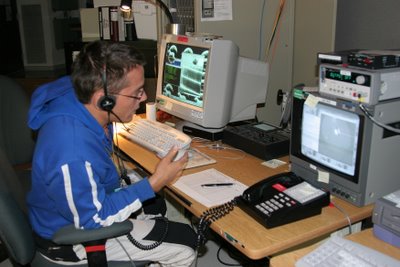The Night Life
And here's the super-exciting night life on Maui. Basically, I've got 6 screens and 7 computers doing things to keep me busy. Today was a total crash course in IR chips. Katie and I went into the code that runs the IR chips. There's a lot of different voltages that perform different functions when going from photons to electrons to a voltage to a number to an image. The kicker was, when none of that worked, we just turned the power off and then on again (just like pulling the plug, but with a million dollar instrument) and everything worked fine. Go figure. So here's the normal routine - I'm on the headset with a dude in the control room who's driving the telescope. I've got a screen that shows me what the telescope sees and what my camera's see.
 Basically, most of the night is hitting the "go" button and writing down what the instruments settings are. Exposure time, settings, weather, etc. The system is a total hack though - most systems have hired operators who make the software and hardware run smoothly. They don't have two new grad students trying to figure it all out on their own. All the software is randomly distributed and hardly connected on 4 different computers, all of which can crash if you click the wrong thing. That's what happens when nobody has the time to do anything right. It's a very unique experience though. Most people who go to Keck or somewhere else walk into a room and tell somebody to take some pictures. I walk into a room, realize that everything is broken and that I have a screwdriver, some tape, and 2 hours to fix it.
Basically, most of the night is hitting the "go" button and writing down what the instruments settings are. Exposure time, settings, weather, etc. The system is a total hack though - most systems have hired operators who make the software and hardware run smoothly. They don't have two new grad students trying to figure it all out on their own. All the software is randomly distributed and hardly connected on 4 different computers, all of which can crash if you click the wrong thing. That's what happens when nobody has the time to do anything right. It's a very unique experience though. Most people who go to Keck or somewhere else walk into a room and tell somebody to take some pictures. I walk into a room, realize that everything is broken and that I have a screwdriver, some tape, and 2 hours to fix it.  This is what a faint star looks like on our "slit viewer" camera. The dark band is a hole in a mirror that lets the starlight into the spectrograph. This "slit-mirror" lets us see what the star is doing while letting most of the light into the instrument.
This is what a faint star looks like on our "slit viewer" camera. The dark band is a hole in a mirror that lets the starlight into the spectrograph. This "slit-mirror" lets us see what the star is doing while letting most of the light into the instrument.  And this is the raw pictures. It doesn't really look like a star does it? Basically, it's a rainbow. The star gets smeared out horizontally with each position being a slightly different wavelength. The bright vertical stripes are either sky emission lines (bright) or absorption bands (dark).
And this is the raw pictures. It doesn't really look like a star does it? Basically, it's a rainbow. The star gets smeared out horizontally with each position being a slightly different wavelength. The bright vertical stripes are either sky emission lines (bright) or absorption bands (dark).  It was neat to get this side working. Amazing how construction of this thing got started about 10 years ago and it hasn't yet made it's way into the normal working mode of most UH telescope time. Nobody is here to run it, it breaks all the time, and the software is so user un-friendly that you have to have many training runs before you can even think of handling it yourself........ Let the good times roll.
It was neat to get this side working. Amazing how construction of this thing got started about 10 years ago and it hasn't yet made it's way into the normal working mode of most UH telescope time. Nobody is here to run it, it breaks all the time, and the software is so user un-friendly that you have to have many training runs before you can even think of handling it yourself........ Let the good times roll.

7 Comments:
Thanks for the explaination =)
so how come that last pic has a bright stripe down every (order? is that what you call each of the lines?) with a not as bright part above and below instead of there being a bright part and lesser bright part on top of each other? Does that make any sense?
i'm a little confused.... the bright horizontal stripe in the center is the star. the glow around it is the sky. if you look at the slit, the star is less than a quarter the length of the slit, so the star's image should only be a quarter of the order. did that help?
I think I'll have to pester you about it in person..
That was sooo clear! Didn't get a single word ;) Nevertheless, good job you two, if only my experiments were running so fine... I could be a doctor!
Later, Gilles
sounds like the DMC if it's broke don't fix it!
Ahh, powercycle, mmmm...
yeah. talk about all the damn stupid stuff to try. it still hasn't really fixed it since it could happen again and we don't know what "it" is anyways, but still. it makes you want to shoot yourself for wasting a day!
Post a Comment
<< Home